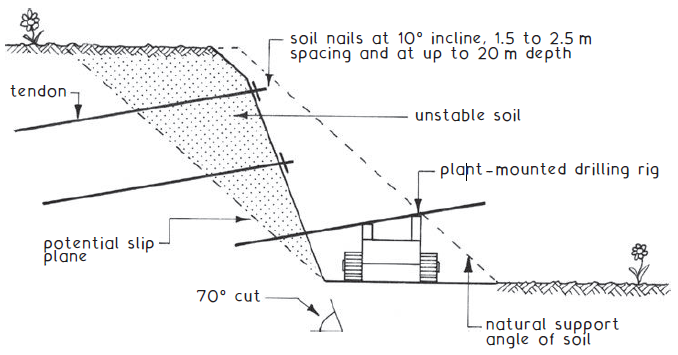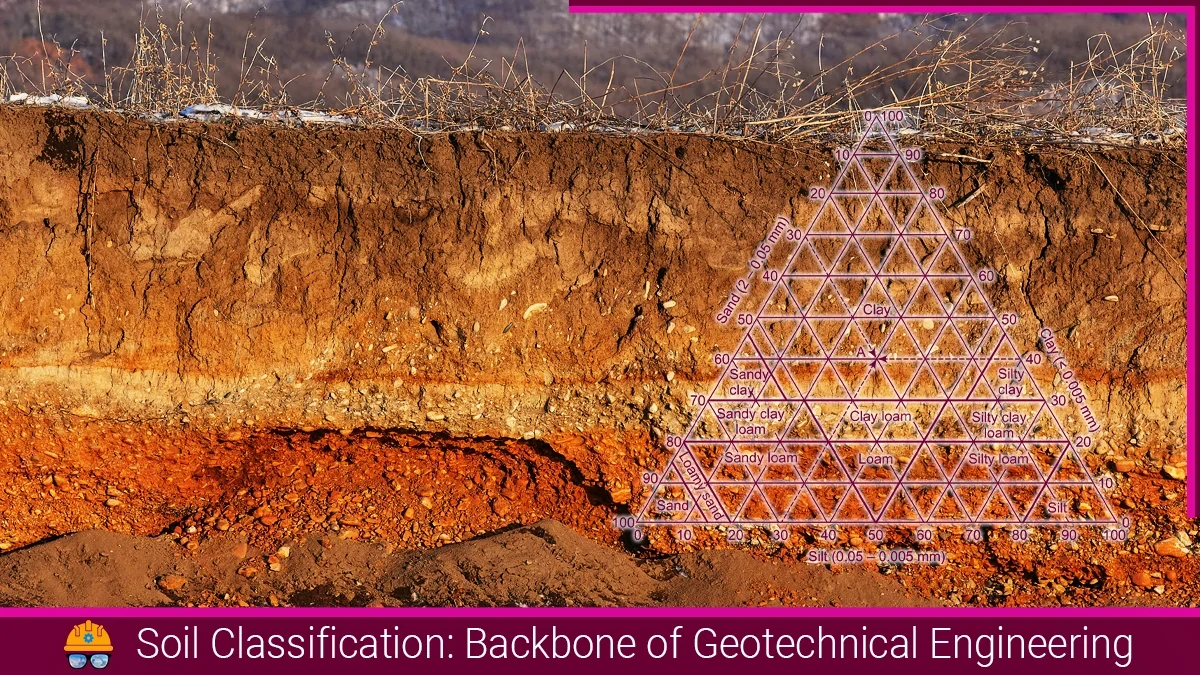When it comes to projects involving slopes, excavations, or retaining walls, one method that has gained significant popularity is soil nailing. This technique offers a reliable and cost-effective solution for reinforcing soil and providing structural stability. In this article, we will explore the concept of soil nailing, its benefits, and its applications in various construction scenarios.
What is Soil Nailing?
Soil nailing is a method employed to stabilize slopes, whether they occur naturally or are excavated, aiming to enhance the structural integrity of the slope. The technique entails the drilling of holes into the slope face, where steel bars are subsequently inserted and secured in place with grout. To maintain the position of the slope face, the mesh is affixed to the ends of the bars.
Soil nailing is a ground improvement technique used to enhance the stability of soil or rock masses. It involves the insertion of slender reinforcing elements, typically steel bars or rods, into the ground at a predetermined angle. These reinforcing elements, known as nails or soil nails, are typically installed in a grid pattern to create a reinforced zone within the soil or rock mass.

Types of Soil Nails or Tendons:
Various types of soil nailing methods are employed in the field.
Grouted Soil Nails:
Grouted soil nails involve injecting a cementitious or chemical grout into the borehole after the nail is installed. The grout provides a bond between the nail and the soil, increasing the overall stability.
Driven Nail:
In this type, nails are mechanically driven to the wall during excavation. Installation of this type of soil nailing is very fast, however, it does not provide good corrosion protection. This is generally used as temporary nailing.
Self-Drilling Soil Nail:
In this type, nails are mechanically driven to the wall during excavation. Installation of this type of soil nailing is very fast, however, it does not provide good corrosion protection. This is generally used as temporary nailing.
Jet Grouted Soil Nailing:
The jet-grouted soil nailing method employs high-pressure jets to erode the soil, creating holes within the slope surface. Subsequently, steel bars are inserted into these holes and securely grouted with concrete. This approach ultimately ensures effective corrosion protection for the steel bars (nails) used in the process.
Also, read: What Is Shotcrete? : Types and Applications
The Process of Soil Nailing:
The soil nailing process begins with a thorough analysis of the ground conditions and the specific requirements of the project. After evaluating the soil type, slope angle, and other relevant factors, engineers design a soil nailing plan tailored to the specific needs of the site.
The installation process typically involves the following steps:
- Drilling: Holes are drilled into the ground at specified locations and angles according to the design. The holes are typically spaced a few feet apart and extend into the stable soil or rock beyond the failure plane.
- Inserting Nails: Reinforcing bars or rods, commonly made of steel, are inserted into the drilled holes. These nails are often coated with corrosion-resistant materials to ensure long-term durability. They are grouted or bonded to the surrounding soil or rock using cementitious or resin-based grout.
- Adding Facing: To protect the nails from external factors and enhance the stability of the system, a facing material such as shotcrete (sprayed concrete) or reinforced soil is applied to the excavated slope. This facing material distributes the loads from the retained soil or rock mass to the nails, thereby providing additional stability.
Also, read: Various Types Of Retaining Walls: A Comprehensive Guide 101
Embankment Treatment
The exposed surface is faced with a plastic-coated wire mesh to fit over the ends of the tendons. A steel head plate is fitted over and centrally bolted to each projecting tendon, followed by spray concreting to the whole face.
Typical Application

Benefits of Soil Nailing:
Soil nailing offers several advantages over traditional stabilization techniques, making it an attractive option for a wide range of applications. Some key benefits include:
- Cost-Effectiveness: Soil nailing is often more cost-effective compared to other methods like retaining walls or deep foundations. It reduces the need for extensive excavation, minimizing material and labour costs.
- Versatility: Soil nailing can be applied to various soil types, including cohesive soils, granular soils, and weathered rock. It is particularly useful in areas where space constraints or restricted access make other stabilization methods impractical.
- Minimal Disruption: Soil nailing minimizes disruption to the surrounding area during construction. It allows for continuous construction and maintains the natural appearance of slopes or embankments.
- Increased Safety: By reinforcing the soil or rock mass, soil nailing enhances the stability of slopes, excavations, or retaining walls, reducing the risk of slope failure or collapse. This increases overall safety for both workers and nearby structures.
Applications of Soil Nailing:
Soil nailing finds applications in various construction scenarios, including:
- Stabilization of cut slopes and embankments along highways, railways, and waterways.
- Protection of existing structures near excavation sites or landslide-prone areas.
- Construction of retaining walls for commercial, residential, or industrial projects.
- Rehabilitation and repair of existing structures affected by soil erosion or settlement.
Also, read: Understanding Lateral Earth Pressure
FAQs:
Q: What is soil nail?
Ans: A soil nail is a slender, often steel, reinforcing element installed in the soil to provide stability to slopes, excavations, or retaining walls. It is typically installed at a slight downward angle into the soil.
Q: What should be the length of the soil nail?
Ans: The length of the soil nail should extend beyond the potential failure plane or slip surface in the soil. This ensures that the nail engages with stable soil and provides sufficient anchorage to resist sliding or overturning. The length of soil nails is usually over 6.00 m long and may be as much as 20 m.
Q: What is soil nailing?
Ans: Soil nailing is a ground reinforcement technique used in geotechnical engineering to stabilize slopes, excavations, and retaining walls. It involves the insertion of slender, closely spaced reinforcing elements (nails) into the soil to improve its stability.
Q: What is the typical lifespan of a soil nail wall?
Ans: The lifespan of a soil nail wall depends on factors such as the design, environmental conditions, and maintenance. Properly designed and constructed soil nail walls can have a long service life.
References:
- Soil nailing. (n.d.). Designing Buildings. https://www.designingbuildings.co.uk/wiki/Soil_nailing
- Wikipedia contributors. (2022, May 7). Soil nailing. Wikipedia. https://en.wikipedia.org/wiki/Soil_nailing
![]()






